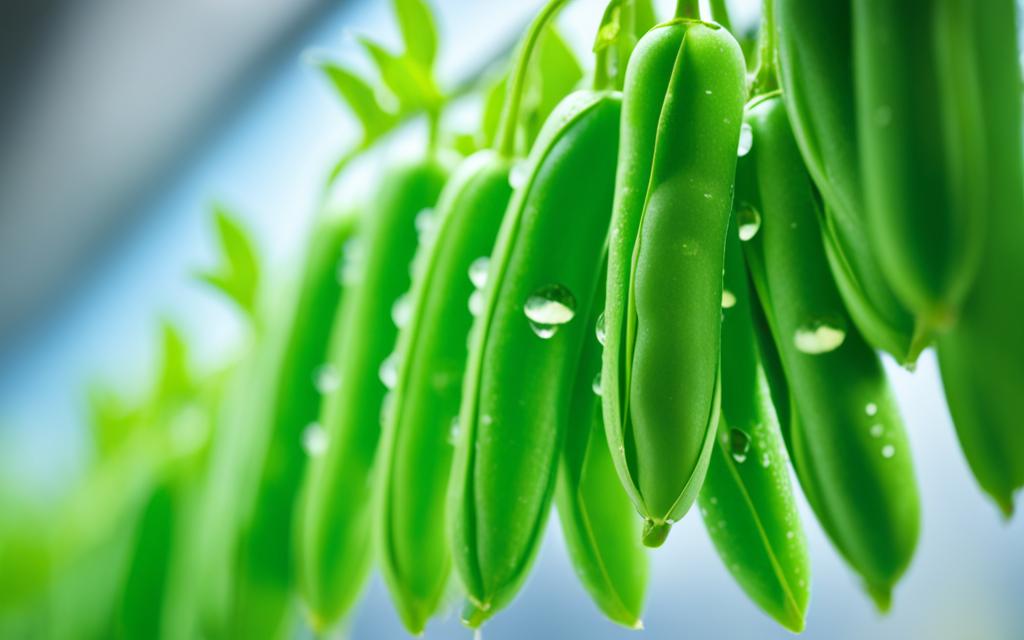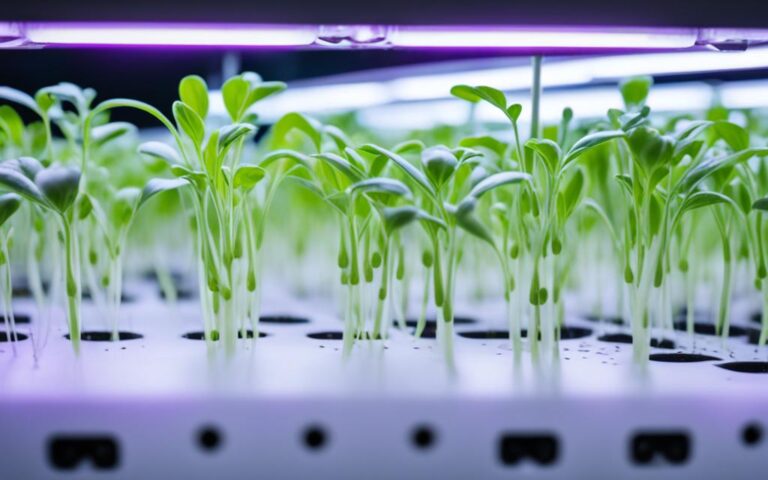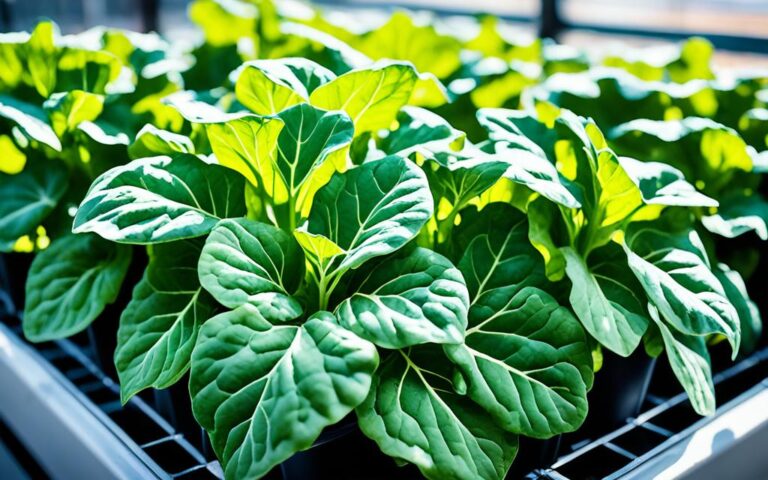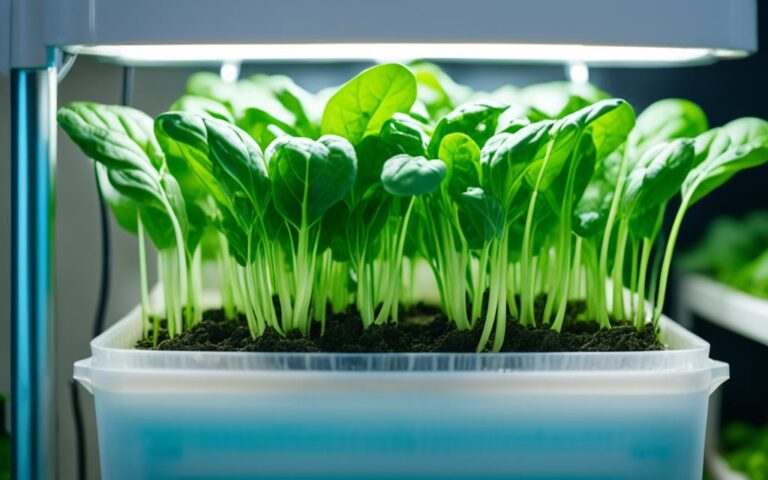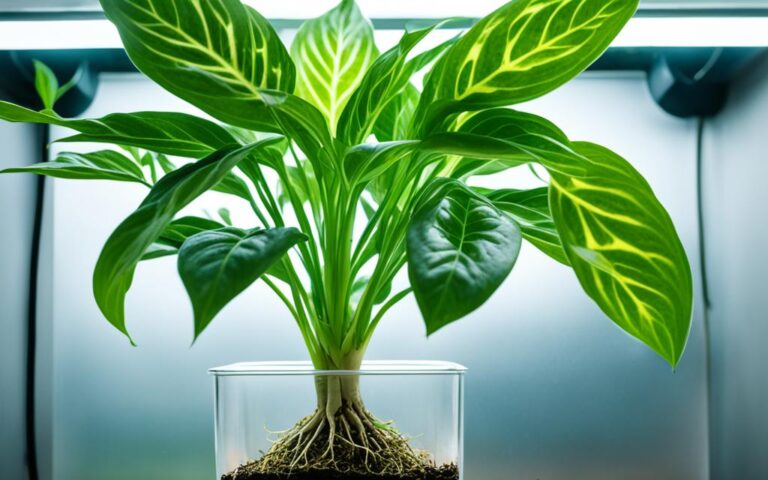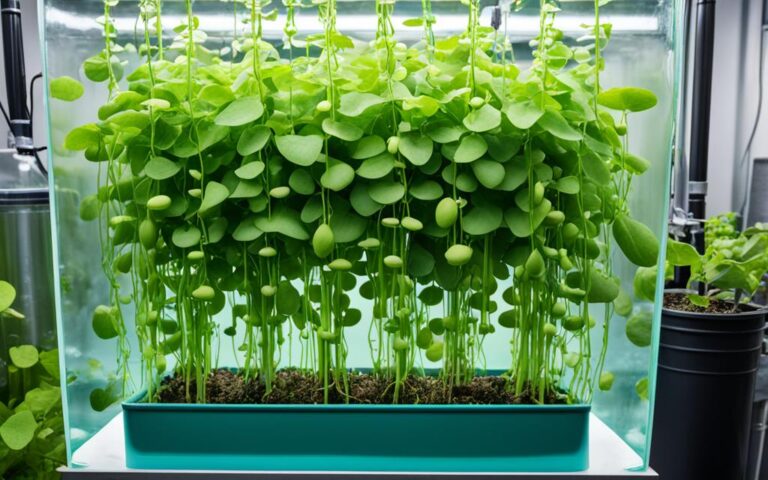Grow Hydroponic Sugar Snap Peas Successfully
Did you know hydroponic sugar snap peas can produce up to 30% more than traditional farming? This new way of growing these tasty veggies brings many benefits. It speeds up growth and boosts their nutritional value. Whether you’re a pro or a beginner, learning hydroponic sugar snap pea growing can open up a world of tasty options at home.
Key Takeaways
- Hydroponic sugar snap pea cultivation can yield up to 30% more than traditional soil-based methods.
- Hydroponic gardening allows for faster maturity and enhanced nutritional value of sugar snap peas.
- Hydroponic systems can reduce susceptibility to pests and diseases compared to soil-based gardening.
- With the right setup, nutrient management, and growing conditions, you can successfully cultivate delicious and nutritious hydroponic sugar snap peas year-round.
- Hydroponic sugar snap pea cultivation offers a versatile and sustainable solution for home gardeners and commercial growers alike.
Introduction to Hydroponic Sugar Snap Pea Cultivation
Hydroponic gardening with sugar snap peas is a new and efficient way to grow these tasty legumes. It uses a soilless method where pea plants get nutrients from a water solution. This method helps plants absorb nutrients better and grow faster. By using hydroponic sugar snap pea cultivation, growers can get healthy, plenty of peas all year.
What is Hydroponic Gardening with Sugar Snap Peas?
Hydroponic gardening means growing plants in a water solution full of nutrients, not soil. For sugar snap peas, this means the roots get the nutrients they need right away. This method cuts out the need for soil, making plants grow better and more efficiently.
Benefits of Growing Sugar Snap Peas Hydroponically
- Faster maturity and higher yields compared to soil-based cultivation
- Reduced susceptibility to pests and diseases, minimizing the need for harsh chemicals
- Ability to grow sugar snap peas year-round in a controlled indoor environment
- Efficient use of water and space, making soilless cultivation of sugar snap peas an ideal choice for urban and small-scale gardeners
Hydroponic sugar snap pea cultivation is a green and productive way to grow these peas. It gives gardeners a steady supply of fresh, healthy peas.
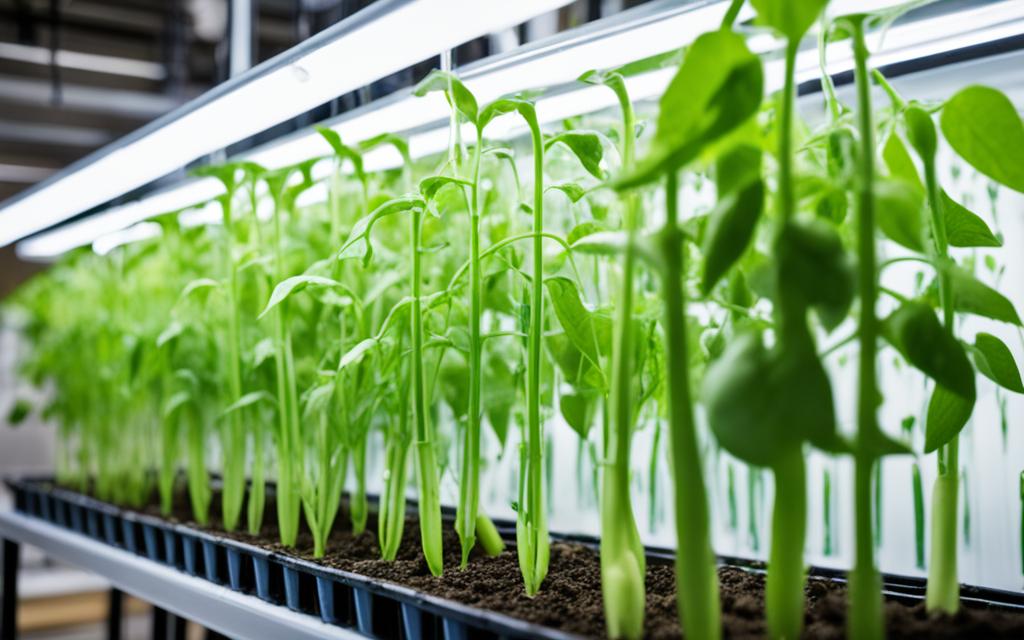
Essential Nutrients for Hydroponic Sugar Snap Pea Growth
For growing sugar snap peas hydroponically, it’s key to give them the right nutrients. These needs are different from growing them in soil. Hydroponics use a special mix of nutrients that plants need to grow well.
Potassium is a must for hydroponic sugar snap peas. It helps roots grow strong, which is important in hydroponics since roots don’t dig into soil. Potassium also makes sure plants can use other important nutrients well.
Vitamin C is another important nutrient. It keeps sugar snap pea plants healthy and strong. This vitamin fights off stress and helps with healthy growth of leaves and stems.
Keeping the pH level right, around 6.5, is also key. This pH helps plants take in nutrients like nitrogen, phosphorus, and small nutrients from the hydroponic solution.
It’s important to watch and adjust the nutrient levels, pH, and electrical conductivity (EC) in the hydroponic solution. Doing this helps sugar snap peas grow well in soilless systems. By managing these factors, growers can help their plants grow strong and healthy.
“Proper nutrient management is the foundation for thriving hydroponic sugar snap pea cultivation.”
Getting Started: Growing Hydroponic Sugar Snap Peas
Starting your hydroponic sugar snap peas journey needs a few key steps. First, focus on germinating the seeds right. This is crucial for a successful hydroponic system. By learning how to germinate sugar snap pea seeds for hydroponics, you help your plants start strong and healthy.
How to Germinate Sugar Snap Pea Seeds for Hydroponics
To start, put the seeds in a damp paper towel or rock wool cubes. Keep it warm and moist, watching for sprouts. This usually takes 5-10 days. After germination, move the seedlings to your hydroponic setup. Make sure they get enough light, water, and nutrients for growing sugar snap peas hydroponically.
The Steps to Growing Sugar Snap Peas Hydroponically
- Germinate the seeds in a damp paper towel or rock wool cubes
- Transfer the sprouted seedlings to your hydroponic system
- Ensure the plants have access to adequate lighting
- Monitor the water pH and adjust as needed to maintain optimal conditions
- Provide the necessary nutrients for the steps to growing sugar snap peas hydroponically
- Regularly check on your pea plants and address any issues that arise
By following these steps and keeping an eye on your starting sugar snap pea seeds for hydroponic systems, you’ll grow a great harvest of hydroponic sugar snap peas.
Pruning and Tending to Sugar Snap Pea Plants
As your hydroponic sugar snap pea plants grow, it’s important to prune them. This helps them grow bushy and prevents them from getting too crowded. Cut the vine tips when they are 8-12 inches long. Also, use a trellis or other support for the vines to help them grow upwards.
Keeping your hydroponic sugar snap pea plants healthy is crucial. Check the plants often for pests or nutrient problems. If you find any, fix them quickly. This way, your pea plants will grow well and produce a lot.
- Prune the tips of the pea vines when they reach 8-12 inches in length to promote bushier growth.
- Provide a trellis or other support structure to help the pea vines climb and thrive.
- Regularly check for pests or nutrient deficiencies and take appropriate action to maintain healthy plants.
“Proper pruning and tending to your hydroponic sugar snap pea plants can make all the difference in achieving a bountiful harvest.”
By following these simple steps, you can make sure your pruning sugar snap pea plants in hydroponic systems and tending to hydroponic sugar snap pea plants are well taken care of. This will help them grow and give you a lot of tasty, fresh peas.
Choosing the Right Sugar Snap Pea Varieties
Choosing the right sugar snap pea varieties is key for a great harvest in hydroponics. Dwarf or bush-type varieties do well in hydroponic systems. They give high yields and tasty pods.
Best Sugar Snap Pea Varieties for Hydroponic Cultivation
Some top sugar snap pea varieties for hydroponic gardens are:
- Sugar Ann – A compact, bushy plant that produces an abundance of sweet, crunchy pods.
- Sugar Snap – A classic snap pea variety known for its tender, stringless pods and impressive yields.
- Super Sugar Snap – A robust plant that can tolerate a range of growing conditions, making it a versatile choice for hydroponic systems.
These varieties are great for indoor gardeners wanting a big sugar snap pea harvest in a hydroponic setup. They grow well and produce a lot, making them perfect for sugar snap pea varieties for indoor cultivation.
| Variety | Plant Habit | Yield Potential | Flavor |
|---|---|---|---|
| Sugar Ann | Dwarf, Bushy | High | Sweet, Crunchy |
| Sugar Snap | Vining | Moderate to High | Tender, Stringless |
| Super Sugar Snap | Compact, Bushy | High | Sweet, Crisp |
By picking the best sugar snap pea varieties for hydroponics, indoor gardeners can have a lot of these tasty legumes all year.
Growing Snap Peas vs. Snow Peas Hydroponically
Hydroponic cultivation offers unique benefits for both snap peas and snow peas. These peas share some traits but also have key differences. These differences can greatly affect your hydroponic garden.
Snap peas are loved for their crunchy pods and sweet taste. They do well in a controlled hydroponic setup. This lets you enjoy their flavor all year. Snow peas, on the other hand, have flat, tender pods. They’re great for stir-fries, salads, and other dishes.
Thinking about growing snap peas and snow peas hydroponically? Here are some main differences:
- Pod Shape and Texture: Snap peas have a round, crunchy pod, while snow peas have a flat, tender pod.
- Flavor Profile: Snap peas are sweeter, while snow peas have a more delicate flavor.
- Culinary Versatility: Snap peas are often eaten raw or lightly cooked. Snow peas are great in stir-fries and salads.
- Growth Habits: Snap peas are more compact and bushy. Snow peas grow taller and need more support.
Try growing both hydroponic snap peas and snow peas to enjoy their unique qualities. No matter which pea you pick, focus on good nutrient management and controlling the environment for a great harvest.
“Hydroponic gardening lets me have crisp snap peas all year. The delicate snow peas add a special touch to my dishes.”
Maximizing Your Harvest with Different Pea Varieties
To get the most from your hydroponic sugar snap pea harvest, plant a mix of pea types at different times. This way, you get fresh peas all season long. It makes sure you have a lot of peas to enjoy.
Love the sweet taste of sugar snap peas or the crisp feel of snow peas? Growing various pea types can make your meals better. By growing different pea varieties for continuous harvest, you can pick peas for longer. This means you always have these healthy legumes on hand.
| Pea Variety | Harvest Timeline | Key Features |
|---|---|---|
| Sugar Snap Peas | Early to Mid-Season | Sweet, edible pods; excellent for snacking |
| Snow Peas | Mid to Late-Season | Flat, crisp pods; great for stir-fries and salads |
| Shelling Peas | Mid to Late-Season | Tender, sweet peas inside the pods; ideal for cooking |
Plan your pea plantings well to maximize your hydroponic sugar snap pea harvest. This way, you’ll have plenty of these versatile veggies all season.
“Growing a variety of pea types allows me to enjoy a continuous harvest and experiment with different culinary applications.”
The secret to a great pea harvest is to grow different pea varieties for continuous harvest. With some planning and a mix of pea plants, you’ll have a season full of peas to enjoy.
hydroponic Sugar Snap Peas Pest Management
Hydroponic systems help reduce pests from the soil. But, sugar snap pea plants can still face pests that harm their growth and yield. It’s key to know these pests and how to stop them to grow hydroponic sugar snap peas well.
Common Pests Affecting Sugar Snap Pea Plants in Hydroponic Systems
Some pests that can harm hydroponic sugar snap pea plants include:
- Aphids: These small insects suck sap, causing stunted growth, yellow leaves, and less yield.
- Thrips: These tiny insects leave silver or white streaks on leaves and pods as they feed.
- Spider mites: These tiny arachnids spin webs and can make leaves turn yellow, wilt, and die.
Preventative Measures and Natural Solutions for Pea Pests
To stop and manage pests in your hydroponic sugar snap pea system, try these steps:
- Keep your plants clean by checking them often and removing any damaged leaves or pods.
- Don’t overwater, as this can make pests grow.
- Add beneficial insects like ladybugs or lacewings to control pests.
- Use natural products like neem oil or insecticidal soap to fight pests safely.
By being careful and using these tips, you can keep your hydroponic sugar snap pea plants healthy and productive. This way, you can reduce the harm from common pests.
Optimizing Indoor Sugar Snap Pea Growth
When growing sugar snap peas indoors, you need good lighting to mimic sunlight. Using grow lights is key for using grow lights for indoor hydroponic sugar snap pea cultivation. Place the grow lights right above the pea plants to help them grow strong and not get too long and weak.
It’s also important to keep the temperature and humidity steady for optimizing indoor environment for hydroponic sugar snap peas. Good air flow and ventilation are also needed for the plants. Keep an eye on your plants and adjust things as needed for the best growth.
- Adjust the light duration based on the specific requirements of your pea varieties.
- Maintain consistent temperature and humidity levels to mimic the ideal outdoor conditions.
- Ensure proper air circulation and ventilation to prevent disease and promote healthy growth.
- Monitor the plants closely and make adjustments as needed to optimize the indoor environment.
“Providing the right lighting and environmental conditions is key to successfully growing sugar snap peas indoors. With the right setup, you can enjoy a bountiful harvest year-round.”
By controlling the indoor environment and using grow lights, you can make a great place for yourhydroponic sugar snap pea cultivation. With some care and tweaks, you’ll get a crop of tasty, fresh peas.
Creating the Ideal Indoor Environment for Pea Shoot Growth
Growing hydroponic sugar snap peas indoors needs careful attention to the environment. It’s key to make the ideal indoor environment for hydroponic pea shoot growth. This ensures strong plant growth and a good harvest, even without outdoor conditions.
To set up the best space for indoor hydroponic pea cultivation, growers must watch and adjust several important factors:
- Temperature: Pea plants do well in a steady temperature of 65-75°F (18-24°C).
- Humidity: Keep humidity between 60-70% to stop mold or mildew.
- Air Circulation: Make sure there’s enough air flow and ventilation for healthy growth and to prevent stagnation.
- Lighting: Give them 12-16 hours of good grow lighting each day, using LED or fluorescent lights made for indoor use.
By carefully managing these factors, indoor hydroponic pea growers can keep the best conditions for pea shoots. This leads to strong, productive pea shoot growth all year.
| Environmental Factor | Ideal Range for Hydroponic Pea Shoots |
|---|---|
| Temperature | 65-75°F (18-24°C) |
| Humidity | 60-70% relative humidity |
| Air Circulation | Adequate ventilation and air flow |
| Lighting | 12-16 hours of grow lighting per day |
By growing pea shoots in a well-controlled indoor space, gardeners can have a steady supply of these tasty and healthy veggies all year. This is true even when outdoor seasons change.
Benefits of Growing Sugar Snap Peas Indoors for Year-round Harvest
Growing hydroponic sugar snap peas indoors lets you have a year-round harvest. This means you can enjoy fresh, homegrown peas all year, not just during the outdoor growing season. By keeping peas in a controlled indoor space, you get a steady supply for your meals and snacks.
Adding pea shoots to salads or eating the sweet pods as a snack is easy with indoor hydroponic pea cultivation. This method gives you a steady source of nutritious peas. You can easily add these versatile veggies to your daily meals, enjoying the perks of growing hydroponic sugar snap peas indoors all year.
Hydroponic sugar snap pea cultivation also has other benefits. It uses less water, needs little soil, and can grow in small spaces. This makes it perfect for city gardeners and those with tiny outdoor areas.
| Benefit | Description |
|---|---|
| Year-round Harvest | Enjoy a steady supply of fresh, homegrown peas regardless of outdoor growing seasons. |
| Versatility in Cuisine | Incorporate pea shoots and pods into salads, snacks, and a variety of dishes. |
| Water Efficiency | Hydroponic systems use significantly less water compared to traditional soil-based gardening. |
| Space-saving | Grow peas in limited indoor spaces, making them ideal for urban and small-scale gardeners. |
With year-round hydroponic sugar snap pea cultivation, you get a steady supply of nutritious, homegrown produce. This adds flavor, texture, and variety to your meals. Enjoy the convenience and sustainability of growing hydroponic sugar snap peas indoors for a bountiful harvest all year long.
Conclusion
Growing hydroponic sugar snap peas is rewarding for both new and seasoned gardeners. It’s important to know what nutrients they need and how to keep pests away. This way, you can have a garden full of these delicious peas all year.
Choosing between indoor or outdoor systems is up to you. But success comes from keeping an eye on your plants and making adjustments as needed. The tips in this article will help you grow tasty peas right in your own space.
With the right steps and patience, you can make the most of growing hydroponic sugar snap peas. They’re versatile and packed with nutrients. So, why not start your own garden and enjoy fresh produce right at home?
